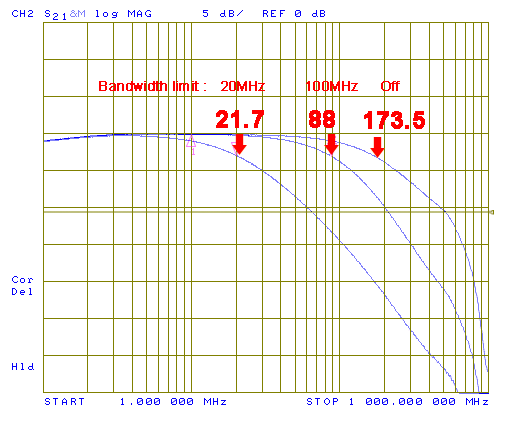Hi,
I think it is a good topic, that has caused us to think about the limitations of DSOs.
Here are some random thoughts on this subject.
Marking or highlighting data pointsIn LTspice you can mark the data points. This is a nice feature, you can easily what data the program is using to create the waveforms.
I can do the same thing on my MDO 4K scope. I would post the picture, but you can visualize sparse dots. This is a handy feature.
The forum is a melting pot with people with different backgroundsSome members of this group are very familiar with the design decisions made in designing a successful scope, their insights are invaluable.
Anti-Aliasing Filter (or lack of one)The LMH6518 used in the Rigol DS2072A, measured by forum member Bud:

is not suitable for anti-aliasing filter. It is only about 20dB / decade.
Sampling Rate and memory depthIn my mind there is no substitute for sampling speed and memory depth.
If we take an AM modulated RF signal, to accurately reproduce the signal you need 5 to 10 samples per period of the RF carrier.
To resolve the AM modulation in an FFT you need about a sample length equal to about 5 cycles of the modulation.
The resolution, bin width, is 1/acquisition time.
You are trying to resolve three components, RF-mod, RF and RF+ modulation.
If we take the thought experiment proposed by 2N3055
50MHz with 100Hz modulation
a sample rate of 50MHz x 5 or greater is needed
to resolve the 100Hz modulation, chose 20Hz bins, so 50ms of acquisition.
It may be better to use a spectrum analyzer?
A spectrum analyzer still needs the acquisition time, but it can reduce the number of sampling rate by mixing with an LO.
Design DecisionsA scope manufacturer could invest time and effort and design software to extract every last drop of performance out of a signal chain.
or they could invest in the acquisition hardware, increase the sample rate, interleave ADCs etc.
And get similar improvements in performance per dollar.
Given the choice of
1GHz bandwidth 2.5Gsps and advanced DSP
or
1GHz bandwidth 5Gsps and modest signal processing.
I would chose the later. I might make the wrong choice.
I have a 1GHz scope, 5Gsps on my bench, not because I am looking at 500MHz signals, because I don't have to be concerned about the scope performance when looking at 100 MHz (and often much less) signals.
Regards,
Jay_Diddy_B